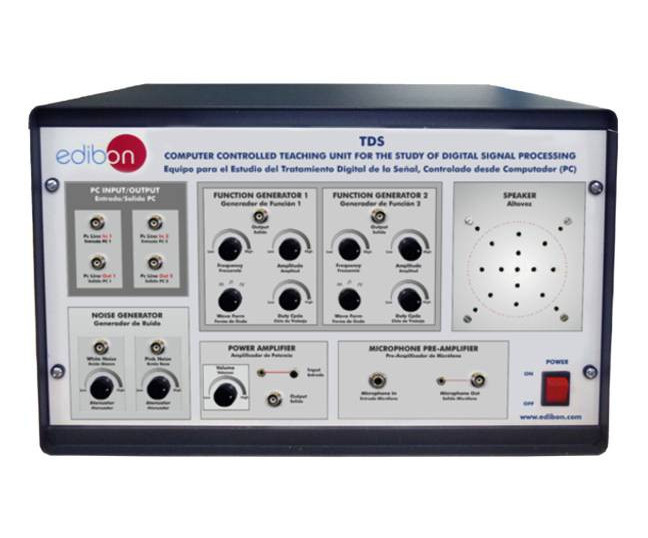TDS 计算机控制的数字信号处理的研究教学设备
創新系統
The Teaching Unit for the Study of Digital Signal Processing "TDS" allows to study the principles and more important concepts about digital signal processing, including study and practical exercises.
化验室
相關新聞
一般說明
The Teaching Unit for the Study of Digital Signal Processing "TDS" allows to study the principles and more important concepts about digital signal processing, including study and practical exercises, among others, of:
- Continuous waveforms generation.
- Analyze the nature of the signals.
- Working simultaneously with two external signals.
- Signals digitalization.
- Fast Fourier Transform visualization.
- Study of the effects of the digital signal processing.
- Study of the effects of the analog and digital filters.
- To analyze the time and frequency responses, before and after the digital signal processing.
- Behaviour of the generated signal or the user’s voice when noise is added to the signal, etc.
- Moreover, it is possible to generate different waveforms by the software and send them to the outputs of the unit. These signals can be visualized by an external oscilloscope or be listened by the speaker.
The "TDS" unit is based on a modular design structure to allows the user a better understanding of the unit. This unit includes the followingmodules:
- Two Function Generators modules: Each function generator contains a waveform selector to choose one of the three different waveformshapes (sine, triangle and square) and three potentiometers to regulate the frequency, the amplitude and the duty cycle of the signal.
- Noise Generator module: It includes two different noise generators: white noise and pink noise. Each noise generator includes a potentiometer to regulate the amplitude of the noise signal.
- Microphone and Microphone Pre-Amplifier module: It allows to record and adapt the user´s voice to be analyzed with the software ofthe unit.
- PC Inputs/Outputs module: It allows to connect the unit with the data acquisition board (to be placed in the computer) and shows theacquired signals in the unit software. This module contains two BNC connectors for signal inputs and two BNC connectors for signal outputs.
- Power Amplifier module: It contains a potentiometer to regulate the power amplification of the signal.
- Speaker module: It allows to hear the generated signals of the unit and to study the effects of the noise and digital signal processing in the studied signal.
All connections between modules are performed through RF coaxial cable assembly.
This Computer Controlled Unit is supplied with the EDIBON Computer Control System (SCADA), and includes: The unit itself + a DataAcquisition Board + Computer Control, Data Acquisition and Data Management Software Packages, for controlling the process and allparameters involved in the process.
練習和指導練習
手册中包含的指导实践练习
- Continuous wave form generation, with the possibility of varying the frequency and amplitude of signals, besides of duty cycle.
- Characterization of signals. To analyze the nature of the signals: sine, square, triangular, etc.
- Working simultaneously with two external signals.
- Generating signals directly by the software and send them to the unit outputs and then visualizing or listening by the speaker or an external oscilloscope.
- Signal digitalization, permitting the most suitable sampling time, avoiding "aliasing".
- Digitalization of signals with the possibility of adjusting the sampling frequency.
- Fast Fourier Transforms (Power Spectrum).
- Addition, subtraction and multiplication of signals.
- Study of "aliasing".
- Study of different noise types:
- White noise.
- 1/ƒ noise.
- Study and use of filters:
- Possibility of filtration of any signal.
- Reconstruction of signals through the application of filters.
- Digital filters: Finite Impulse Response (FIR) Filters and Infinite Impulse Response (IIR) Filters.
- Analogue filters: Butterworth, Chebyshev, etc.
- Possibility to use Bartlett, Hanning, Hamming, Kaiser, Parzen, etc. windows for applying on the signal.
与该单位进行更多实际操作
- Many students view results simultaneously. To view all results in real time in the classroom by means of a projector or an electronic whiteboard.
- This unit is totally safe as uses mechanical, electrical and electronic, and software safety devices
- This unit can be used for doing applied research.
- This unit can be used for giving training courses to Industries even to other Technical Education Institutions.
- Several other exercises can be done and designed by the user.
配套设备
模拟-数字转换器模块
数字-模拟转换器模块
数字系统与转换器模块
数字电子学基础模块
基本组合电路模块
基本顺序电路模块
计算机控制的A/D和D/A转换器单元(PC)
質量

售後服務

 Cookies首选项
Cookies首选项















